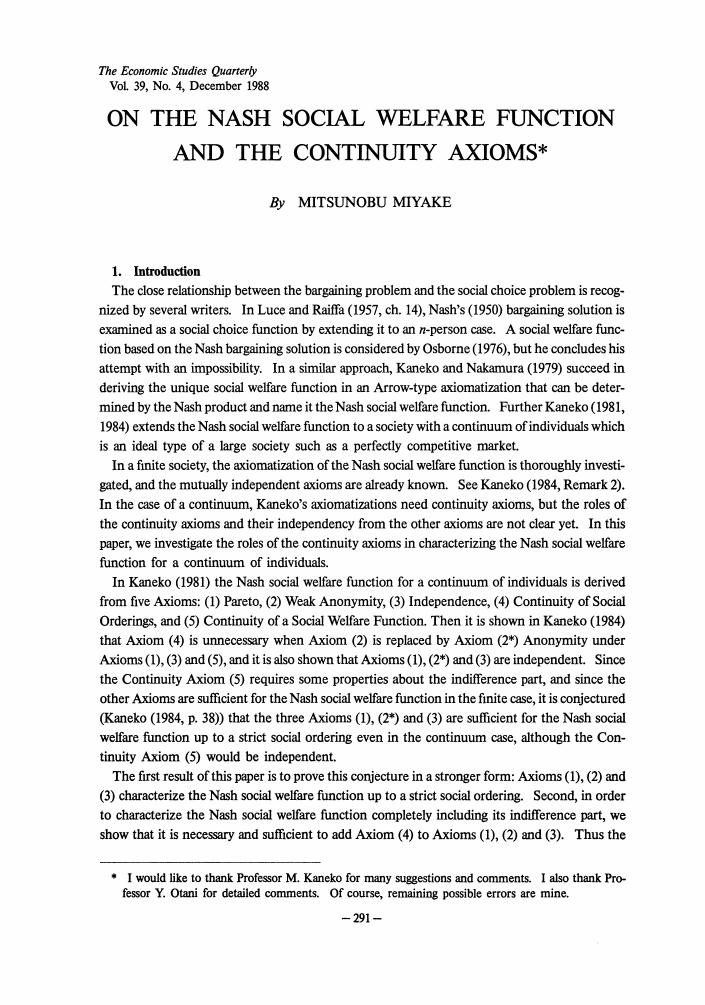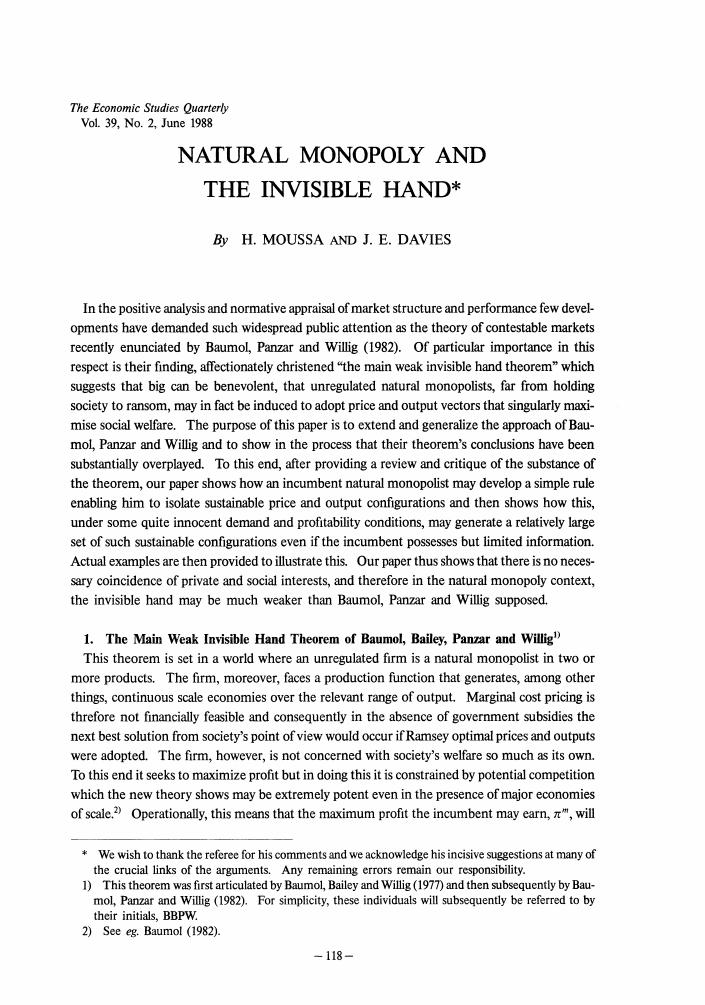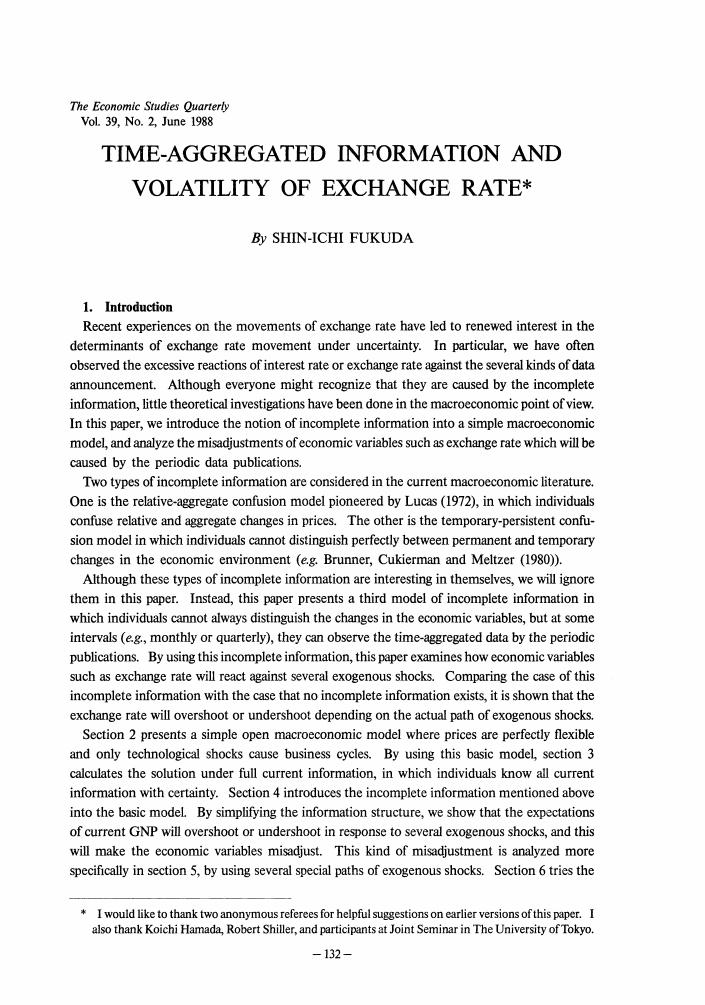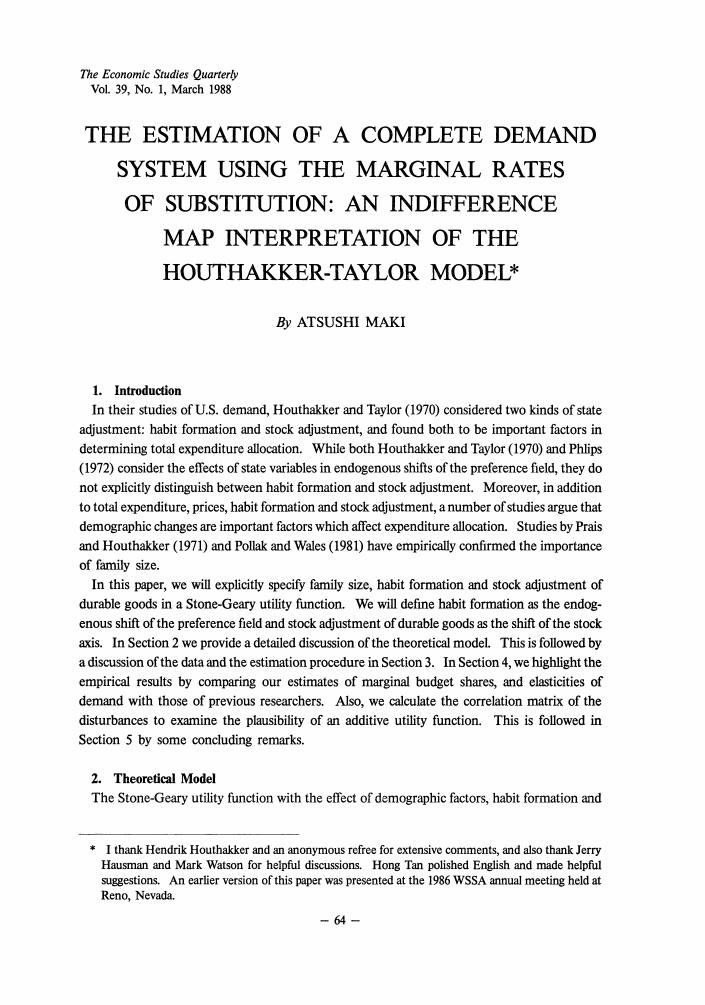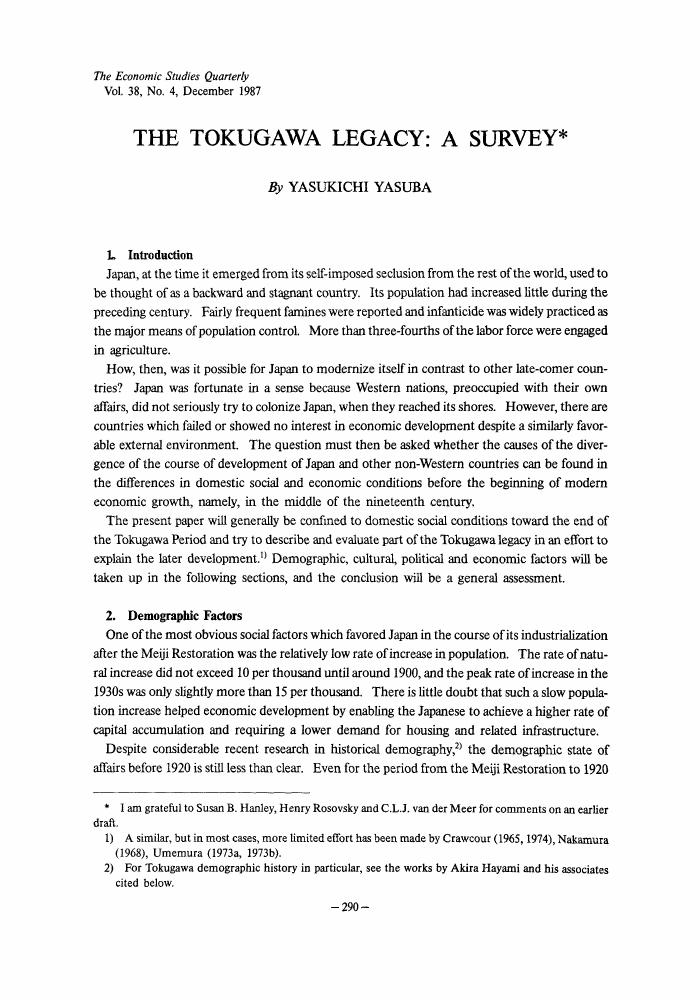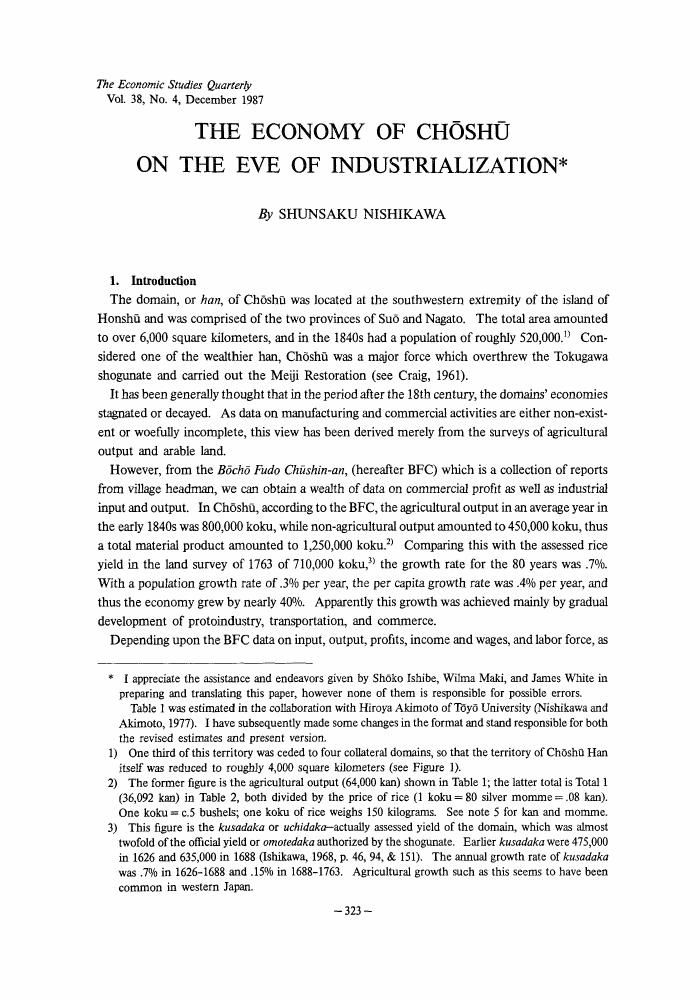1 0 0 0 OA Symposium on Game Theory and Economics
- 著者
- MAMORU KANEKO MASAHIRO OKUNO-FUJIWARA
- 出版者
- JAPANESE ECONOMIC ASSOCIATION
- 雑誌
- The Economic Studies Quarterly (ISSN:0557109X)
- 巻号頁・発行日
- vol.39, no.4, pp.289-290, 1988-12-20 (Released:2007-10-19)
- 著者
- MITSUNOBU MIYAKE
- 出版者
- JAPANESE ECONOMIC ASSOCIATION
- 雑誌
- The Economic Studies Quarterly (ISSN:0557109X)
- 巻号頁・発行日
- vol.39, no.4, pp.291-302, 1988-12-20 (Released:2007-10-19)
- 参考文献数
- 16
1 0 0 0 OA NATURAL MONOPOLY AND THE INVISIBLE HAND
- 著者
- H. MOUSSA J. E. DAVIES
- 出版者
- JAPANESE ECONOMIC ASSOCIATION
- 雑誌
- The Economic Studies Quarterly (ISSN:0557109X)
- 巻号頁・発行日
- vol.39, no.2, pp.118-131, 1988-06-20 (Released:2007-10-19)
- 参考文献数
- 4
- 著者
- SHIN-ICHI FUKUDA
- 出版者
- JAPANESE ECONOMIC ASSOCIATION
- 雑誌
- The Economic Studies Quarterly (ISSN:0557109X)
- 巻号頁・発行日
- vol.39, no.2, pp.132-148, 1988-06-20 (Released:2007-10-19)
- 参考文献数
- 10
- 著者
- SHINJI TAKAGI
- 出版者
- JAPANESE ECONOMIC ASSOCIATION
- 雑誌
- The Economic Studies Quarterly (ISSN:0557109X)
- 巻号頁・発行日
- vol.39, no.2, pp.149-159, 1988-06-20 (Released:2007-10-19)
- 参考文献数
- 24
1 0 0 0 OA IMPERFECT MARKETS IN MACROECONOMICS
- 著者
- COSTAS AZARIADIS
- 出版者
- JAPANESE ECONOMIC ASSOCIATION
- 雑誌
- The Economic Studies Quarterly (ISSN:0557109X)
- 巻号頁・発行日
- vol.39, no.3, pp.193-207, 1988-09-20 (Released:2007-10-19)
- 参考文献数
- 55
- 著者
- GIORGIO BRUNELLO
- 出版者
- JAPANESE ECONOMIC ASSOCIATION
- 雑誌
- The Economic Studies Quarterly (ISSN:0557109X)
- 巻号頁・発行日
- vol.39, no.3, pp.208-215, 1988-09-20 (Released:2007-10-19)
- 参考文献数
- 13
- 著者
- MARCUS NOLAND
- 出版者
- JAPANESE ECONOMIC ASSOCIATION
- 雑誌
- The Economic Studies Quarterly (ISSN:0557109X)
- 巻号頁・発行日
- vol.39, no.3, pp.216-232, 1988-09-20 (Released:2007-10-19)
- 参考文献数
- 25
1 0 0 0 OA “A Stabilization Model” AFTER TWENTY YEARS
- 著者
- MASAHIRO TATEMOTO
- 出版者
- JAPANESE ECONOMIC ASSOCIATION
- 雑誌
- The Economic Studies Quarterly (ISSN:0557109X)
- 巻号頁・発行日
- vol.39, no.1, pp.1-13, 1988-03-20 (Released:2007-10-19)
- 著者
- NAOSUMI ATODA TERUKAZU SURUGA TOSHIAKI TACHIBANAKI
- 出版者
- JAPANESE ECONOMIC ASSOCIATION
- 雑誌
- The Economic Studies Quarterly (ISSN:0557109X)
- 巻号頁・発行日
- vol.39, no.1, pp.14-40, 1988-03-20 (Released:2007-10-19)
- 参考文献数
- 33
A large number of functional forms have been estimated for income distribution in Japan with an emphasis on selecting appropriate functional forms. Five estimation procedures, namely (1) Pearsonian β1 and β2 method, (2) matching moments, (3) least squares, (4) minimum chi-square, and (5) maximum likelihood. Some adjustments have been made for correcting the influence of the number of parameters in the functions, namely (1) PC and (2) AIC criteria have been considered. Some statistical test has been attempted to examine whether it was possible to eliminate one parameter. Attention has been paid to investigating the difference in parameter values and in inequality by several occupations, and between primary income figures and redistributed income figures.Followings are the summary of the results. The Pearsonian β1 and β2 method gives us a preliminary idea on estimation. It is, however, risky to rely on this method. Method of matching moments is preferable to least squares method or minimum chi-square method for the functions which are supposed to be symmetric a priori. We relied mainly on minimum chi-square method as an estimation procedure to select appropriate functional forms. It is feasible to conclude that the three parameters' functions provide better fits than the two parameters' functions except for a few cases. Statistical test, however, suggests that there are several cases such that one parameter could be eliminated without losing the substance. Since a fewer parameters are definitely desirable for the interpretation purpose, reduction in parameters is recommended in such cases. As for the fitting, following results have been obtained. The normal and lognormal provide in general the poorest fit except for a rare case, i.e., Self-employed. The Gamma and Generalized Gamma give better results than the previous two functions. The Beta provides considerably better fit which is consistent with the preliminary result by the Pearsonian β1 and β2 method. The J-shaped Beta is especially useful for the particular case (i.e., farmers' primary income). The Singh-Maddala function gives in general excellent performances. In some case, however, the functions can be replaced by either the log-logistic or the Weibull statistically. A trade-off between them was argued. The Johnson (SB) shows a unique result in the sense that when the distribution is highly skewed, it is considerably useful. The sample experimentations due to various occupations and primary/redistributed incomes suggest, finally, that those are considerably crucial for the determination of the most appropriate density functions.
- 著者
- BOBBY E. APOSTOLAKIS
- 出版者
- JAPANESE ECONOMIC ASSOCIATION
- 雑誌
- The Economic Studies Quarterly (ISSN:0557109X)
- 巻号頁・発行日
- vol.39, no.1, pp.41-63, 1988-03-20 (Released:2007-10-19)
- 参考文献数
- 102
- 著者
- ATSUSHI MAKI
- 出版者
- JAPANESE ECONOMIC ASSOCIATION
- 雑誌
- The Economic Studies Quarterly (ISSN:0557109X)
- 巻号頁・発行日
- vol.39, no.1, pp.64-76, 1988-03-20 (Released:2007-10-19)
- 参考文献数
- 14
1 0 0 0 OA GROWTH POTENTIAL IN A NONCAPITALIST ECONOMY
- 著者
- TOYOAKI WASHIDA
- 出版者
- JAPANESE ECONOMIC ASSOCIATION
- 雑誌
- The Economic Studies Quarterly (ISSN:0557109X)
- 巻号頁・発行日
- vol.39, no.1, pp.77-86, 1988-03-20 (Released:2007-10-19)
- 参考文献数
- 16
1 0 0 0 OA DID THE GASOLINE PRICE INCREASES CHANGE CONSUMER EVALUATIONS OF CARS IN JAPAN DURING 1970-83?
- 著者
- MAKOTO OHTA
- 出版者
- JAPANESE ECONOMIC ASSOCIATION
- 雑誌
- The Economic Studies Quarterly (ISSN:0557109X)
- 巻号頁・発行日
- vol.39, no.1, pp.87-92, 1988-03-20 (Released:2007-10-19)
- 参考文献数
- 5
- 著者
- ISAO OHASHI
- 出版者
- JAPANESE ECONOMIC ASSOCIATION
- 雑誌
- The Economic Studies Quarterly (ISSN:0557109X)
- 巻号頁・発行日
- vol.39, no.2, pp.97-117, 1988-06-20 (Released:2007-10-19)
- 参考文献数
- 43
The present paper has developed a two-period model of specific human capital incorporating the decision of the firm on the amount of investment in on-the-job training, and analyzed the effects of the specificity of the skill, formal schooling and unions on the wage and the quit rate by operating compartive statics. This attempt is valuable particularly in discussing the problem of why earnings and quits differ among workers and industries, since the amount of investment in on-the-job training is a key factor in the wage determination.One of the main conclusions is that an increase in the specificity of the skill leads to an increase in the wage rate of skilled workers because it incites the firm to invest more in them through reducing their quit possibility. The effects of formal schooling on the wage and the quit rate depend on how it affects both the efficiency of on-the-job training and the difference in productivity between the present and the alternative employment. For, if the productivity increase is sufficiently larger in the alternative employment than in the present, then the firm will refrain form investing in highly educated workers.We have tested the implications of our model by estimating it in the structural form, using the procedures of OLS and INST, and by computing White's statistic as well as t-ratio. In so doing, the bonus-earnings ratio and firm size were used as a proxy for the amount of specific training.One result of the analysis is that, as our model has described, the strong interaction between wages and quits plays a crucial role in the determination of earnings in the Japanese labor market, which is often characterized by the“rigid”institutions, such as the nenko-wage and the lifetime employment system. It is also interesting that both the firm-scale dummies and the bonusearnings ratio are significantly influential in the quit equations while not in the wage equations. This supports one of the important implications of our model that the specificity of the skill does not affect earnings directly, but indirectly through changing the quit possibility of skilled workers.
1 0 0 0 OA Takeshi Amemiya, ADVANCED ECONOMETRICS Cambridge: Harvard University Press, 1985, pp. 521, $39.50
- 著者
- 森棟 公夫
- 出版者
- JAPANESE ECONOMIC ASSOCIATION
- 雑誌
- The Economic Studies Quarterly (ISSN:0557109X)
- 巻号頁・発行日
- vol.38, no.3, pp.283-285, 1987-09-30 (Released:2008-02-28)
- 参考文献数
- 2
1 0 0 0 OA THE TOKUGAWA LEGACY: A SURVEY
- 著者
- YASUKICHI YASUBA
- 出版者
- JAPANESE ECONOMIC ASSOCIATION
- 雑誌
- The Economic Studies Quarterly (ISSN:0557109X)
- 巻号頁・発行日
- vol.38, no.4, pp.290-308, 1987-12-20 (Released:2008-02-28)
- 参考文献数
- 92
- 著者
- SUSAN B. HANLEY
- 出版者
- JAPANESE ECONOMIC ASSOCIATION
- 雑誌
- The Economic Studies Quarterly (ISSN:0557109X)
- 巻号頁・発行日
- vol.38, no.4, pp.309-322, 1987-12-20 (Released:2008-02-28)
- 参考文献数
- 34
- 著者
- SHUNSAKU NISHIKAWA
- 出版者
- JAPANESE ECONOMIC ASSOCIATION
- 雑誌
- The Economic Studies Quarterly (ISSN:0557109X)
- 巻号頁・発行日
- vol.38, no.4, pp.323-337, 1987-12-20 (Released:2008-02-28)
- 参考文献数
- 17
1 0 0 0 OA THE IMPACT OF THE OPENING OF THE PORTS ON DOMESTIC JAPANESE INDUSTRY: THE CASE OF SILK AND COTTON
- 著者
- SHINYA SUGIYAMA
- 出版者
- JAPANESE ECONOMIC ASSOCIATION
- 雑誌
- The Economic Studies Quarterly (ISSN:0557109X)
- 巻号頁・発行日
- vol.38, no.4, pp.338-353, 1987-12-20 (Released:2008-02-28)
- 参考文献数
- 29

